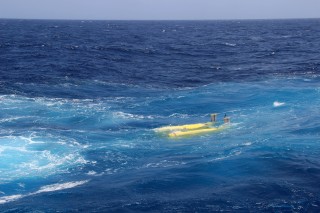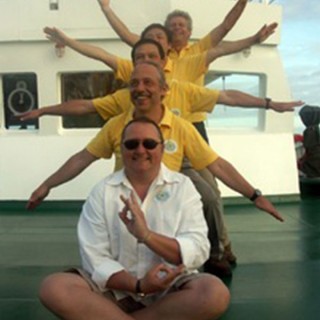
Up early again today for our first Nereus dive in earnest, heading down to 2250m at the top of Mt Dent, just West of the Von Damm hydrothermal field, for engineering tests.
After a few concerns right before diving (waiting for the coffee to kick in and provide clarity) we were ready to go and soon we had slipped the line, Nereus was descending and it was time for breakfast around 7am. Another hour and Nereus arrived at the seafloor right on schedule ready to start running missions. Like a coild spring we waited to see what would transpire. And then we waited some more. By about 9am we realized that all was not going to plan. Something was inhibiting Nereus from rising back up from the seafloor where it had landed and flying the survey lines we had planned, more than 100m above the seabed. Instead, it was trying to follow the same lines but proceeding very slowly at heights that were typically ranging between 10m and 30m above the seafloor. Hmmmm…. Another hour passed and Mike and James ran through many possibilities of what might be going on. Through our acoustic communications links we had reams of engineering data arriving back at the ship but there was only one truly diagnostic test that was going to help them resolve the issue before it was going to be time to cut the dive short, and call Nereus home early from the seafloor. So at 10:30 we decided to let Nereus drift out over deep water for an hour, maintaining its constant depth, so we could safely conduct one final “cut all engines” test and see whether it would continue to float at the same depth or begin to sink toward the seabed. A good plan. So we waited an hour and when I checked back in with the Nereus team, the vehicle had floated in a different direction over similar depth or even shallower terrain. Not helpful. We extended another hour and were making no progress. By 12:30 it was time to cut our losses. We signaled the appropriate code and Nereus headed back to the surface and home. Judging my timing quite splendidly (though I say so myself) I arrived on the Bridge just in time to see the vehicle arrive on the surface at about 2pm (I actually spotted it about 30 seconds before it broke through the surface, rising like a giant yellow tuna from the deeps) and by 2:30 Nereus was safely back on deck.
Knowing that we needed to repeat the engineering dive tomorrow AND that I suddenly had an extra 6h available on top of the 10h I had already planned out for overnight, we set sail immediately to the Piccard hydrothermal field, about 20 miles NNE of Von Damm for 2 CTD casts. The first is for Meg who is specially interested in the nature of the particles that form around hydrothermal systems in the plumes that rise up from the seabed vents. Turns out that this is exactly what I was working on when I was first a post-doc working at MIT and WHOI about 25 years ago. Not surprisingly, Meg’s techniques are a lot more sophisticated than anything I ever used back then, but it means we were particularly motivated to get this cast right. And boy did we ever. On the way down we had to make sure that we could safely lower the CTD-rosette all the way down to this, the world’s deepest vent-site and still have enough strength in the Falkor’s cables to haul our treasure trove of water samples back on board. I am very happy to report that we were able to manage this, getting all the way to 5000m of cable paid out, and got just the samples we were hoping for with about 3m of cable to spare!!!! Phew!!!! At about 4000-4200m water depth we intercepted the horizontal lens of hydrothermal plume smoke that disperses away from the vent-site through the water column – a bit like a cloud of smoke blowing down-wind from a factory chimney on a breezy day. But another 750m deeper, and about 20 minutes after we had passed through that plume, we found our CTD intercepted even smokier – and warm! – water just above the seabed. The only possible interpretation was that we were in the rising jet of fluids rising above the vent-site itself at the Black Smokers we call the Beebe Vents in the NW corner of the Piccard field. Since it only takes about an hour for the fluids exiting these chimneys to rise all the way up to 4200m, the samples were we collecting had probably only exited the seafloor at temperatures close to 400°C a few minutes before Meg sent the order and Jimbo closed the bottles to collect the samples our team will analyze. On the way back up, over the next hour or so (we had to raise the CTD slowly to make sure we didn’t overtax the winch, that close to its maximum capacity) we actually had evidence that we re-intercepted that same rising jet on 6 occassions before finally getting the chance to sample the horizontal spreading layer.
This cast was truly exceptional. It can be rather straightforward to locate and sample the horizontally spreading portion of a plume but much of the interesting geochemical processes that take place which dictate the impact that seafloor venting has on ocean budgets takes place in those first seconds and minutes between when the vent-fluids erupt from the seafloor and when the dilute plume reaches the density level at which it spreads sideways, about an hour later. Sampling that narrow, concentrated jet, is something of a holy grail for hydrothermal geochemists but tonight, thanks to the great skill of our Captain and Officers who managed to place the ship and instruments in just the right place, and with the help of Leighton, Nathan and Jimbo our marine techs, we collected a suite of samples that, in some circles, should become the stuff of legend. [It’s OK, not everyone reading this blog has to be that much of a nerd – we can’t all be cool hipsters who just drive around and go bowling. Speaking of which…
While Meg’s CTD cast was already proving great delight, Mike called me though to the Dry Lab to see some of the results from the Nereus dive. While the exact cause of the problems from today’s dives are still under discussions that will likely continue (I am off to bed before the 2nd CTD cast so I can be up for tomorrow’s launch), a happy accident of the dive was that Nereus spent a significant amount of time flying close above the seabed at Mt Dent, West of the Von Damm field in an area where we had predicted there should be additional venting. Sure enough in the course of its travels, there was at least one occasion today when, flying just above the seabed, Nereus had intercepted co-incident signals in Ko-ichi’s Eh sensor that sniffs for hydrothermal chemicals and in our temperature probe: warm fluids.
The lesson for tonight? Sometime the dive eats you… …sometimes you eat the dive.
Nereus abides.

